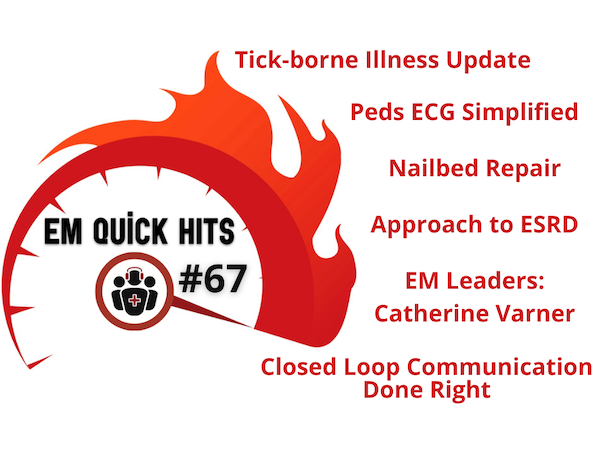EM Quick Hits 67 Tick Borne Illness Update, Pediatric ECG Interpretation, Nailbed Repair, Closed Loop Communication, ESRD, Leaders in EM Dr. Catherine Varner
- Author
- Dr. Anton Helman
- Published
- Tue 26 Aug 2025
- Episode Link
- https://emergencymedicinecases.com/em-quick-hits-august2025/
Topics in this EM Quick Hits podcast
Isaac Bogoch on tick borne illness update - anaplasmosis and babesiosis (1:30)
Matthew McArther on evidence-based update in nailbed repair (9:32)
Kathleen Stephanos on simplified approach to pedatric ECG interpretation (19:05)
Shawn Segeren on closed loop communication done right (30:36)
Brit Long on basic approach to end stage renal disease (36:02)
Catherine Varner & Victoria Myers on leadership and career choices in EM (44:08)
Podcast production, editing and sound design by Anton Helman
Podcast content, written summary & blog post by Anton Helman, August, 2025
Cite this podcast as: Helman, A. Bogoch, I. McArther, M. Stephanos, K. Segeren, S. Long, B. Myers, V. Varner, C. EM Quick Hits 67 - Tick Borne Illness Update, Pediatric ECG Interpretation, Nailbed Repair, Closed Loop Communication, ESRD, Leaders in EM Dr. Catherine Varner. Emergency Medicine Cases. August, 2025. https://emergencymedicinecases.com/em-quick-hits-month-year/. Accessed September 14, 2025.
Tick Borne Illnesses Beyond Lyme: Don’t Miss Co-Infections
Why it matters: Warmer, shorter winters are expanding tick ranges; Lyme is rising and under-reported. Same Ixodes ticks can transmit anaplasmosis and babesiosis—co-infection rates up to ~10–20% in highly endemic US regions. Think broadly.
When to test for tick borne illnesses
If you’re ordering Lyme serology, also order anaplasma and babesia testing, especially with non-localizing febrile illness after tick exposure or travel from tick country.
Erythema migrans: treat empirically for Lyme; serology may be negative early. Still send Lyme serology to aid downstream decision-making. Repeat if symptoms persist.
Treatment cues
Anaplasmosis: often covered by your Lyme doxycycline course; clue = fever + leukopenia.
Babesiosis: not covered by doxy; treat like malaria (e.g. atovaquone + azithromycin). Order specific testing.
Bottom line: If you thought “order Lyme,” add anaplasma + babesia—and tailor treatment if babesiosis is in play.
Expand to view reference list
Lantos PM, Rumbaugh J, Bockenstedt LK, et al. Clinical practice guidelines by the IDSA, AAN, and ACR: 2020 guidelines for the prevention, diagnosis and treatment of Lyme disease. Clin Infect Dis. 2021;72(1):e1-e48.
Krause PJ, Auwaerter PG, Bannuru RR, et al. IDSA 2020 guideline on diagnosis and management of babesiosis. Clin Infect Dis. 2021;72(2):e49-e64.
Biggs HM, Behravesh CB, Bradley KK, et al. Diagnosis and management of tick-borne rickettsial diseases: Rickettsia, Ehrlichia, and Anaplasma. MMWR Recomm Rep. 2016;65(2):1-44.
Diuk-Wasser MA, Vannier E, Krause PJ. Coinfection by the tick-borne pathogens Babesia microti and Borrelia burgdorferi: ecological, epidemiological, and clinical consequences. Trends Parasitol. 2016;32(1):30-42.
Nail Bed Injuries: Faster, Simpler—Without Sacrificing Outcomes
Evidence refresh
Skin glue vs sutures: Similar cosmetic/functional outcomes; skin glue is significantly faster.
NINJA Trial (peds) & adult RCT: After standard nail bed repair, discarding the nail is as good as replacing/suturing it.
